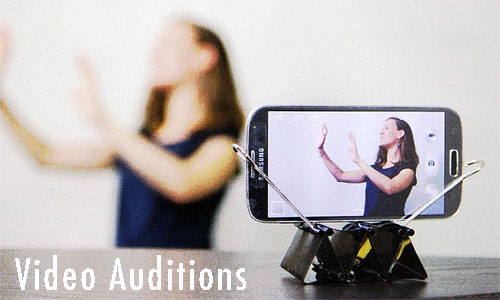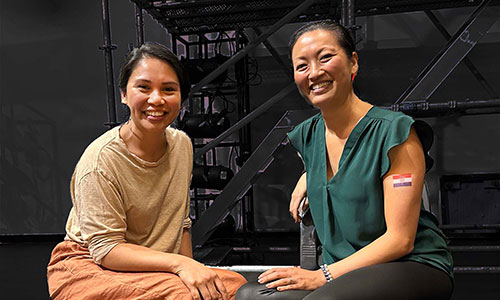Theatre companies, currently dark because of the coronavirus pandemic, are still looking eagerly to the day when they can reopen. To that end, many are conducting online auditions via video submissions, since they cannot hold them in person. If you want to audition while stuck at home, here are some simple tips to help with your setup and your performance. Watch the video, or read the transcript below.
THE SET-UP
- Test your equipment and setup. Record a few seconds of your audition piece and then play it back, making sure everything works, looks, and sounds properly.
- Control your environment, paying attention to your background, wardrobe, lighting, and sound. If it helps your confidence, a little makeup can’t hurt, but it’s not necessary.
The ideal background—and the clothes you wear—should be neutral rather than busy. Make the director focus on you, free of distractions.
Ideal lighting is natural (rather than colored). Professional TV studios use an overhead key light, an eye-level fill light, and a back You can get much of the same effect for your virtual audition using your overhead house lights and eye-level natural light from your window. (Back lighting helps professional video look more three dimensional, but is probably overkill for this purpose.) Don’t shoot yourself in front of a bright window, however, or you may end up in silhouette.
Your sound needs to be audible and free of background noise or echoes. While a shotgun or lavalier mic might be advantageous for a professional self-tape, your camera’s built-in mic will probably suffice for most community theatre auditions, especially if you are standing close to the camera as recommended in the next tip.
- Frame your shot from the waist up in what is called a “medium close-up” (unless the audition notice specifies otherwise) so that the casting director can appreciate your physicality. Using this cropping also frees you to incorporate natural gestures that support your meaning.
-

Don’t have a tripod? You can make do with a couple of binder clips.
Keep the camera stable. Shaky recordings diminish even the best performances. Use a tripod if you have one, or simply prop it up on any stable surface. Get someone to help you record if possible; never hold the camera at arms’ length (selfie-style).
- Mind the fourth wall. Look directly at the camera when you start your recording, and give your name and the role you are seeking, plus the name of the song/monolog you will be doing. This is called the “slate.” You could even hold up a card with this information printed on it, or use an editing program to add the information as a “lower third” title. This is especially helpful if your name has an unusual spelling. Once you begin your performance, however, readjust your gaze just to the left or right of the camera, but not all the way to profile. We want to see your face.
THE PERFORMANCE
- Perform as you would in person. Stand (with your weight balanced), unless the scene demands that you sit. Standing enables you to feel grounded, energized and helps with breath control and projection.
- Be off-book. Memorize your audition piece. You’ll look much more natural than if you’re reading from the libretto.
- If at first you don’t succeed… Shoot as many takes as you want to get the one that makes you look your best, but don’t shoot too many times or you’ll get stale and your voice could suffer. Some auditions ask for just 32 bars of your song, so you should be able to do it all in one unbroken take (i.e. don’t use editing software to splice in a correction after the fact).
- Embody your character. Do more than just sing the song. Use all of your acting skills to make the character believable. You can either portray the character who sang the song in the original musical or you can re-interpret the song to make it your own. But make sure your acting choices feel deliberate and consistent.
- Be Fearless.Perform with confidence, and know that the artistic staff is grateful you took the effort to submit your talent. We are rooting for you!
That’s it! Once you’re done, name the video file with your first and last name and perhaps the name of the show or the role you want before sending it in. (Don’t use a default name like “MyMovie.mov.” Try something like “JohnDoe_Potiphar.mp4” instead.) Double-check that you’ve followed all instructions (e.g. including your headshot, resume, conflict calendar, etc.) and send it in. Most companies prefer to receive video auditions via email rather than being sent a publicly accessible YouTube link, since auditions are supposed to be confidential.
Good luck, and thanks for helping to keep the arts alive during troubled times!
Contributors to this article: Doug Hughes, Sara Dean, Diane Milo. Featured image by Jim Talkington on Dramatics.org. Stock video licensed through InVideo.io.




Leave A Comment